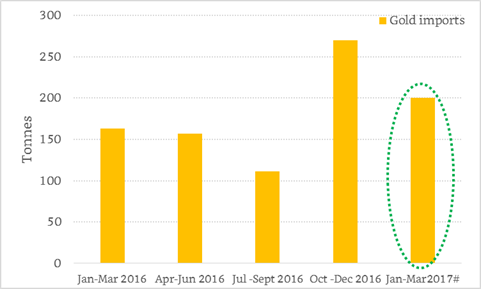Gold and U.S. Dollar (US$) share an inverse correlation. To be precise, interest rates in the U.S. and US$ denominated gold prices share a negative correlation.
If you are a seasoned investor, you would know this.
If you are not, now you do.
But an unusual thing is happening these days.
Despite the US Federal Reserve's firm move to increase rates, gold prices are rising.
Interestingly, India too, has been importing more gold since the beginning of 2017. India imported 50 tonnes of gold in January, and this ascended to 80 tonnes in February. As per the industry estimates, India's gold imports for the Jan-March quarter are pegged at 200 tonnes.
The upsurge in gold imports…

# Estimated
(Source: Business Standard, dated March 20, 2017)
What are the reasons for such a rise in the demand?
Let's try to decode this mystery…
- After Mr Donald Trump became President of the United States of America, the Dollar Index (DXY) —an index that measures the strength of US$ against the basket of 6 major currencies — witnessed an unprecedented rise. Within 50 days of him winning the presidential elections, DXY jumped a massive 5.4%. Concurrently, the US$-denominated gold dropped a little over 10%.
However, the contrasting situation emerged since the beginning of 2017. DXY has lost 3.5%, while the precious yellow metal has gained over 7%. It seems both these assets had over-reacted to the changing political and economic situation in the U.S. Those who were anticipating a much higher US$ were betting against gold, and dumped the precious yellow metal. It seems that the upswing we are witnessing now in the gold prices, attributes largely to future market positions, where short position are getting squared off.
- As far as the gold market in India is concerned, demand jumped on the back of a festive season, during the October-December quarter. Moreover, demonetisation knocked off the inventories of jewellers as black money holders pounced on gold in an attempt to protect their black wealth. Do you remember reading about jewellery shops running overnight on the day demonetisation was announced by Prime Minister, Modi?
Between November 9 - December 30, 2016, gold prices depreciated 10.6% globally, while in India the loss in sheen was to tune of 8.7%. However, between December 31, 2016 to March 17, 2017, gold gained sheen 7.3% in the international market, while in India; these went up just 3.5%. Now the jewellers have started re-stocking, driving gold imports higher. They expect festive and wedding season demand to remain healthy over next 6-8 weeks. Akshaya Tritiya (falling in the fourth week of April this year) is considered an auspicious day to buy gold and so is Gudi Padwa falling on March 28, 2017.
- A strong Indian Rupee(INR) vis-à-vis US$ makes imports cheaper. Recently, INR claimed a 16-month high against US$. The resilience depicted by the INR too has had a bearing on gold in India.
- Over last 1 year, INR has remained one of the strongest emerging market currencies on REER (Real Effective Exchange Rate). However, many experts believe, any further rise in the value of INR will start hurting the Indian exports. The RBI has been trying to arrest the appreciation in INR by buying US$ in the forward market. This would mean the unprecedented rise in INR might drive-in-reverse in the future. Jewellers and stockiest are trying to make the most of the gold and currency market trends, buying relentlessly. This has pushed gold imports upwards.
The gold demand trend going forward; what should investors in gold do?
As the impact of demonetisation fades, it could bode well for gold, especially with auspicious gold buying
muhurats – Gudi Padwa, Akshaya Tritiya – and wedding muhurats from April to July. The World Gold Council (WGC) expects the gold demand in India to revive after touching a seven-year low (514 tonnes) in 2016. It expects consumers to buy anywhere between 650 tonnes and 750 tonnes in 2017. "Over time, we anticipate that economic growth and greater transparency within India's gold market will push demand higher: by 2020 we see Indian consumers buying between 850 tonnes and 950 tonnes," the report says.
However, the report has cautioned that the ban on cash transactions over Rs 3,00,000 could hurt rural Indian demand while implementation of Goods and Services Tax (GST) could adversely affect the industry in the short-term.
Also, flush in liquidity after bumper crop produce on good monsoon and central Government employees' and pensioners' inflation-busting wage hike are supportive factors. It is noteworthy that around 1/3rd of the gold demand come from the rural, agricultural households who often purchase in cash.
Over time, consumers will move away from cash towards digital payments, and organised players should benefit from this trend. This change in market dynamics will result in more transparency and a better deal for consumers, protecting them from shady practices such as under-carating, the WGC has said.
PersonalFN believes, the globally uncertainty looming is a compelling reason to invest in gold. 'Trumponomics' in force (resulting in uncertainties due to Trump's protectionist policies), rising inflation expectations in the US, the process for 'Brexit' underway, geopolitical tensions, not very encouraging macroeconomic variables in the Eurozone, slowdown in China; are some of the key reasons why you should strategically allocate a portion of your investible surplus to gold as a smart investor.
Gold is not just a commodity, but an effective portfolio diversifier and hedge. Thus, it should be approached as safe haven. We think allocating at least 10%-15% of your entire portfolio to gold and holding it with a long term investment horizon will be a prudent strategy. It would act as store of value in times of economic uncertainties. You may buy
gold Exchange Traded Funds (ETFs) or
Sovereign Gold Bonds– which are smart ways to invest in gold vis-à-vis buying gold in physical form.
Add Comments